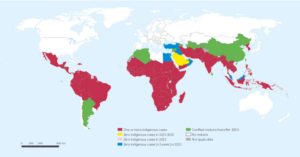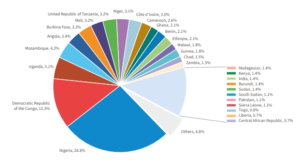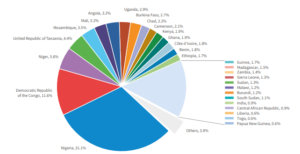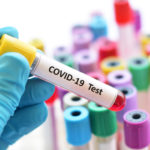
Striving for Zero Malaria
Striving for Zero Malaria
Malaria continues to be a major global health challenge, particularly in regions with limited access to healthcare resources and infrastructure. The transmission of malaria across five WHO regions, encompassing 84 countries, underscores the widespread nature of the disease and the need for concerted efforts to combat it. The achievement of malaria-free status in the WHO European since 2015 is a significant milestone and demonstrates that with effective strategies, it is possible to eliminate malaria even in areas where it was once endemic 1.
Overview of Malaria
Malaria, a potentially fatal illness, is caused by parasites transmitted through the bites of infected female Anopheles mosquitoes. While malaria does not spread directly from person to person, it can be transmitted through blood transfusion or the use of contaminated needles. Although preventable and treatable, malaria persists as a significant public health concern, particularly in areas with limited resources 2.
Malaria in humans is caused by five species of Plasmodium parasites: P. falciparum, P. knowlesi, P. malariae, P. ovale, and P. vivax. Among these, P. falciparum and P. vivax are the most prevalent and present the highest risk, with P. falciparum being the most lethal 2.
Malaria symptoms vary in severity and can manifest as breathing difficulties, chills, confusion, fatigue, fever, headache, and seizures. Severe cases, especially those attributed to Plasmodium falciparum (P. falciparum), can advance quickly and result in mortality if not promptly addressed 2.
Some populations face an elevated risk of severe infection, such as infants, children under the age of five, expectant mothers, individuals with HIV/AIDS, and travellers to regions where malaria is prevalent 2.
The early diagnosis and prompt treatment of malaria is crucial for preventing complications and reducing mortality rates 2.
Burden of Disease
In 2022, an estimated 249 million cases of malaria and 608,000 malaria-related deaths occurred across 85 endemic countries (refer to figure 1). The WHO African region accounted for 94% (233 million) of global malaria cases and 95% (580,000) of global malaria-related deaths 2, 3.
Figure 1: Countries with indigenous cases in 2000 and their status by 2022 3

WHO: World Health Organization
- Malaysia has a significant number of indigenous malaria cases caused by Plasmodium knowlesi infection.
- Countries with zero indigenous cases for at least 3 consecutive years are considered to have eliminated malaria. In 2022, Malaysia reported zero indigenous cases caused by human Plasmodium species for the fifth consecutive year and Cabo Verde reported zero indigenous cases for the fourth year. Belize was certified malaria free in 2023, following 4 years of zero malaria cases.
Incidence
Figure 2 illustrates the unequal distribution of malaria burden, with a notable concentration of cases in select countries. Specifically, a substantial proportion of global malaria cases are reported in just four nations. Nigeria represents 26.8% of all cases, the Democratic Republic of the Congo (DRC) accounts for 12.3%, Uganda for 4.2%, and Mozambique for 4.2%. Collectively, these countries contribute nearly half of all malaria cases worldwide. This emphasises the considerable malaria burden they shoulder and underscores the critical need for prevention, diagnosis, and treatment interventions to effectively combat the disease in these regions 3.
Figure 2: Global Malaria Cases 3

From 2021 to 2022, a number of countries witnessed a rise in malaria cases, with significant contributions observed from Pakistan, Ethiopia, Nigeria, Uganda, and Papua New Guinea. The following presents a breakdown of the fluctuations in incidence and the factors underlying the surge in cases 3.
Pakistan 3:
- Witnessed a notable surge in malaria cases, totalling 2.1 million.
- The incidence escalated fivefold, from 2.2 to 11.5 cases per 1000 population at risk.
- Potential contributing factors encompass climate variations, healthcare accessibility, and vector control strategies.
Ethiopia 3:
- Recorded an uptick of 1.3 million malaria cases.
- Incidence surged by 32%, rising from 46.3 to 60.9 cases per 1000 population at risk.
- Factors potentially influencing this rise include environmental shifts, healthcare accessibility, and socioeconomic factors.
Nigeria 3:
- Registered an increase of 1.3 million malaria cases, although the incidence rate remained stable.
- The rise in cases primarily stemmed from population growth rather than an elevation in the incidence rate.
Uganda 3:
- Saw an increase of 597,000 malaria cases.
- Incidence marginally rose by 2%, from 262.9 to 267.8 cases per 1000 population at risk.
- Despite the relatively modest increase in incidence, the additional cases represent a significant burden.
Papua New Guinea 3:
- Experienced a surge of 423,000 malaria cases.
- Incidence spiked by 32%, climbing from 124.3 to 163.7 cases per 1000 population at risk.
- Contributing factors include environmental alterations, insecticide resistance, and challenges in healthcare delivery to remote regions.
While incidence rates have somewhat stabilised, these increases underscore the persistent challenges in malaria control. Intensified efforts are warranted in prevention, diagnosis, and treatment, particularly in regions witnessing a rise in incidence rates 3.
Mortality
Figure 3 below highlights the substantial impact of malaria in specific countries, with nearly one-third of global malaria deaths attributed to Nigeria (31.1%). Additionally, four nations collectively account for slightly more than half of global malaria fatalities: Nigeria (31.1%), the Democratic Republic of the Congo (11.6%), Niger (5.6%), and the United Republic of Tanzania (4.4%) 3.
These figures underscore the disproportionate burden of malaria-related deaths carried by a select few countries, with Nigeria bearing the greatest share once again. The Democratic Republic of the Congo, Niger, and the United Republic of Tanzania also confront significant hurdles in addressing malaria-related mortality. Moreover, Nigeria’s alarming percentage of global malaria deaths among children under 5 (38.5%) emphasises the urgent need for targeted interventions to safeguard this vulnerable demographic 3.
Figure 3: Global Malaria Deaths 3

Social & Economic Toll
The economic burden of malaria is substantial, affecting both individuals and governments in various ways 4:
Costs to individuals and families 4:
- Purchase of treatment: Individuals often incur expenses in buying drugs for treating malaria, either over-the-counter or prescribed.
- Healthcare expenses: This includes costs associated with seeking medical care at dispensaries or clinics, including consultation fees, diagnostic tests, and hospitalisation if necessary.
- Travel costs: Expenses related to transportation to healthcare facilities for treatment.
- Lost days of work: Malaria can lead to absenteeism from work, resulting in lose income for individuals and their families.
- Education disruption: Absence from school due to illness affects educational attainment and imposes additional costs on families.
- Preventive measures: Costs associated with purchasing preventive measures such as insecticide-treated bed nets or mosquito repellents.
- Funeral expenses: In cases of malaria-related deaths, families may incur expenses for burial arrangements.
Costs to governments 4:
- Healthcare infrastructure: Governments bear the costs of maintaining, supplying, and staffing healthcare facilities for malaria treatment and prevention.
- Procurement of drugs and supplies: Expenses related to purchasing anti-malarial drugs, diagnostic kits, and other medical supplies.
- Public health interventions: Costs associated with implementing public health interventions, such as insecticide spraying, distribution of bed nets, and malaria awareness campaigns.
- Lost productivity: Malaria-related absenteeism leads to lost productivity, affecting economic output and government revenue.
- Impact on economic growth: Malaria’s burden on the workforce and productivity hampers economic growth and development, leading to significant long-term costs.
Over economic impact 4:
- Direct costs associated with illness, treatment, and premature death amount to at least $12 billion USD per year.
- However, the indirect costs, including lost economic growth, are likely to be significantly higher, impacting the overall development of malaria-endemic countries.
Comprehensively tackling malaria not only enhances public health outcomes but also aids in economic development by cutting healthcare costs, boosting productivity, and nurturing economic expansion 4.
Elimination of Malaria
The vision articulated by the World Health Organization (WHO) and the global malaria community is both ambitious and imperative for public health. Achieving a malaria-free world necessitates concerted endeavours from governments, health organisations, communities, and individuals worldwide 5.
It is acknowledged that countries are at varying stages in their malaria elimination efforts. Progress hinges on several factors, encompassing the robustness of national healthcare systems, investment in elimination strategies, and socio-economic conditions. Moreover, biological determinants such as mosquito vector behaviour and drug resistance, along with environmental factors, exert significant influence 5.
As of January 2024, WHO has certified 43 countries and 1 territory as malaria-free. This certification signifies substantial strides in the global battle against malaria. Nevertheless, it also underscores persisting challenges and the imperative for sustained vigilance and investment to prevent the resurgence of transmission in these regions 5.
Realising the vision of a malaria-free world necessitates countries to uphold and reinforce their malaria control and elimination endeavours. This includes bolstering surveillance, vector control, access to treatment, and community engagement. Collaboration among nations, international organisations, researchers, and other stakeholders is indispensable for the exchange of knowledge, resources, and best practices to expedite global progress towards malaria elimination 5.
Importance of Diagnostics
WHO’s recommendation for prompt malaria diagnosis using microscopy or rapid diagnostic tests (RDTs) is pivotal for effective disease management and surveillance. This approach enables healthcare providers to swiftly differentiate between malarial and non-malarial fevers, ensuring appropriate treatment and minimising unnecessary use of antimalarial drugs 6.
Parasite-based diagnostic testing not only enhances patient care but also aids in reducing the morbidity and mortality associated with malaria. By accurately identifying cases, it helps prevent the emergence and dissemination of drug resistance. This strategy aligns with WHO’s objective of ensuring quality-assured diagnosis, which is fundamental for effective malaria control and elimination endeavours 6.
The increased proportion of patients undergoing malaria diagnostic tests since WHO’s recommendation in 2010 reflects advancements in implementing this approach. Nonetheless, sustained efforts are required to ensure universal access to quality-assured diagnostic testing, particularly in regions with limited healthcare infrastructure 6.
By adhering to WHO’s guidelines for malaria diagnosis and treatment, healthcare providers can enhance patient outcomes, reinforce surveillance systems, and contribute to global endeavours to combat malaria effectively 6.
How Biorex Can Help
Biorex offer ELISAs and rapid tests for the diagnosis of malaria.
| Description | Cat Code | Kit Size | Category |
| Malaria | BXE0691A | 96T | ELISA |
| Malaria Ab | BXE0692A | 96T | ELISA |
| Malaria Device P.Falciparum | PFC00020 | 20T | Rapid Test |
| Malaria Device P.Falciparum | PFC00040 | 40T | Rapid Test |
| Malaria Device – Pan Malarial | PVC00020 | 20T | Rapid Test |
| Malaria Device – Pan Malarial | PVC00040 | 40T | Rapid Test |
Quote our promotional code ‘MALARIA24’ for a discount on Malaria products.
References
- World Health Organization (WHO). Malaria. https://www.who.int/data/gho/data/themes/malaria (accessed 22 March 2024).
- World Health Organization (WHO). Malaria. https://www.who.int/news-room/fact-sheets/detail/malaria (accessed 22 March 2024).
- World Health Organization (WHO). World Malaria Report 2023. https://iris.who.int/bitstream/handle/10665/374472/9789240086173-eng.pdf?sequence=1 (accessed 22 March 2024).
- Centers for Disease Control and Prevention. Malaria’s Impact Worldwide. https://www.cdc.gov/malaria/malaria_worldwide/impact.html (accessed 22 March 2024).
- World Health Organization (WHO). Global Malaria Programme – Elimination. https://www.who.int/teams/global-malaria-programme/elimination (accessed 8 April 2024).
- World Health Organization (WHO). Global Malaria Programme – Diagnostic Testing. https://www.who.int/teams/global-malaria-programme/case-management/diagnosis (accessed 8 April 2024).







